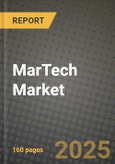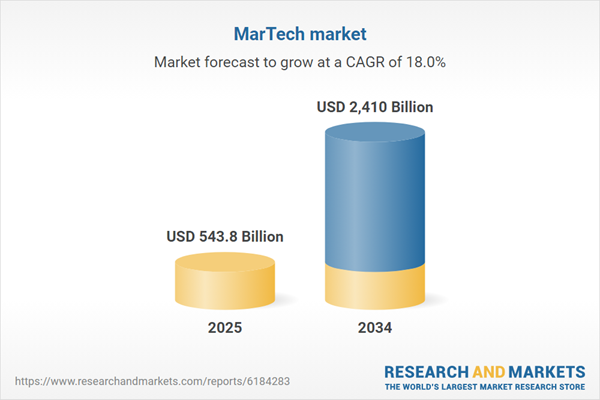MarTech market
The MarTech market comprises the software, data, and services stack that powers modern customer acquisition, engagement, conversion, and retention across B2C and B2B enterprises. Platforms span customer data platforms (CDP), marketing automation, journey orchestration, email/SMS/push, paid media and retail media management, analytics and attribution, consent and privacy tooling, content and asset management, social/creator tooling, and experimentation. Adoption is propelled by the shift to first-party data strategies, privacy-by-design architectures, and measurable growth mandates amid rising acquisition costs. Leading brands favor consolidated suites for governance and roadmap control, augmented with best-of-breed apps for agile use cases and channel innovation. Generative AI accelerates creative production, audience insights, and campaign operations, while retail media and commerce-native advertising create new performance levers. Demand for real-time decisioning, incrementality measurement, and closed-loop revenue reporting expands, tying MarTech more tightly to sales, service, and data teams. Competitive dynamics are defined by cloud and CRM leaders, adtech-to-martech convergers, and vertical specialists; differentiation centers on identity resolution, omnichannel activation breadth, model transparency, ecosystem depth, and total cost of ownership. Barriers include fragmented data estates, signal loss from platform privacy changes, regulatory complexity, and organizational silos between marketing, product, and IT. Vendors demonstrating durable identity, native privacy/consent, proven ROI, and fast time-to-value through templates and low-code configuration are best positioned to win consolidating budgets.MarTech market Key Insights
- First-party identity as the anchor
- Suite consolidation with selective best-of-breed
- Generative AI in the workflow
- Real-time decisioning and journey orchestration
- Measurement beyond last click
- Privacy, consent, and governance
- Retail media and commerce-native ads
- B2B revenue architecture
- Content supply chain modernization
- Total cost and time-to-value
MarTech market Reginal Analysis
North America
Mature MarTech estates prioritize consolidation, privacy controls, and measurable growth under budget scrutiny. Real-time orchestration, AI-assisted operations, and retail media integrations see strong uptake. Enterprises demand cross-functional governance spanning marketing, product, data, and security, with clean-room partnerships and finance-grade attribution driving vendor selection. Services partners and outcome-based engagements are common.Europe
Strict privacy regimes shape architecture toward consent-centric data design, on-prem/cloud-sovereign options, and granular regional controls. Multilingual content supply chains, omnichannel loyalty, and direct-to-consumer pivots spur investment. Interoperability with analytics, call centers, and e-commerce platforms is critical, while independent audits and documentation influence procurement. Sustainability reporting within campaigns is a rising differentiator.Asia-Pacific
Mobile-first consumer behavior, super-app ecosystems, and social commerce fuel rapid experimentation and channel growth. Brands value cost-efficient activation at scale, localized messaging, and integrations with regional ad platforms and payment rails. Data sovereignty considerations guide cloud choices. Partnerships with local MSPs and creator marketplaces accelerate adoption and performance.Middle East & Africa
Government-led digital agendas and expanding e-commerce catalyze MarTech modernization. Organizations prioritize cloud onboarding, Arabic-language and RTL support, and omnichannel service that blends marketing with customer care. Retail and financial services drive demand for identity, consent, and robust analytics. Vendors offering rapid deployment and regional data hosting stand out.South & Central America
Economic variability favors solutions with clear ROI, flexible pricing, and strong partner ecosystems. Social and messaging channels dominate engagement; WhatsApp-centric journeys and localized payments are crucial. Brands invest in first-party data foundations, loyalty programs, and attribution that ties media to sales. Managed services help offset in-house skill gaps and speed time-to-value.MarTech market Segmentation
By Offering
- Software
- Services
By Marketing Type
- Online (Digital)
- Offline
By Enterprise Size
- SMB
- Large Enterprises
By End-User
- BFSI
- Media & Entertainment
- Telecommunications
- Real Estate & Construction
- Healthcare & Life Sciences
- Manufacturing
- Retail & E-Commerce
- Education
- Travel & Hospitality
- Transportation & Logistics
- Others
Key Market players
Adobe, Salesforce, HubSpot, Oracle, SAP Emarsys, Microsoft, Twilio (Segment), Braze, Klaviyo, Iterable, Zoho, Sprinklr, Hootsuite, Mailchimp (Intuit), ZendeskMarTech Market Analytics
The report employs rigorous tools, including Porter’s Five Forces, value chain mapping, and scenario-based modelling, to assess supply-demand dynamics. Cross-sector influences from parent, derived, and substitute markets are evaluated to identify risks and opportunities. Trade and pricing analytics provide an up-to-date view of international flows, including leading exporters, importers, and regional price trends.Macroeconomic indicators, policy frameworks such as carbon pricing and energy security strategies, and evolving consumer behaviour are considered in forecasting scenarios. Recent deal flows, partnerships, and technology innovations are incorporated to assess their impact on future market performance.
MarTech Market Competitive Intelligence
The competitive landscape is mapped through proprietary frameworks, profiling leading companies with details on business models, product portfolios, financial performance, and strategic initiatives. Key developments such as mergers & acquisitions, technology collaborations, investment inflows, and regional expansions are analyzed for their competitive impact. The report also identifies emerging players and innovative startups contributing to market disruption.Regional insights highlight the most promising investment destinations, regulatory landscapes, and evolving partnerships across energy and industrial corridors.
Countries Covered
- North America - MarTech market data and outlook to 2034
- United States
- Canada
- Mexico
- Europe - MarTech market data and outlook to 2034
- Germany
- United Kingdom
- France
- Italy
- Spain
- BeNeLux
- Russia
- Sweden
- Asia-Pacific - MarTech market data and outlook to 2034
- China
- Japan
- India
- South Korea
- Australia
- Indonesia
- Malaysia
- Vietnam
- Middle East and Africa - MarTech market data and outlook to 2034
- Saudi Arabia
- South Africa
- Iran
- UAE
- Egypt
- South and Central America - MarTech market data and outlook to 2034
- Brazil
- Argentina
- Chile
- Peru
Research Methodology
This study combines primary inputs from industry experts across the MarTech value chain with secondary data from associations, government publications, trade databases, and company disclosures. Proprietary modeling techniques, including data triangulation, statistical correlation, and scenario planning, are applied to deliver reliable market sizing and forecasting.Key Questions Addressed
- What is the current and forecast market size of the MarTech industry at global, regional, and country levels?
- Which types, applications, and technologies present the highest growth potential?
- How are supply chains adapting to geopolitical and economic shocks?
- What role do policy frameworks, trade flows, and sustainability targets play in shaping demand?
- Who are the leading players, and how are their strategies evolving in the face of global uncertainty?
- Which regional “hotspots” and customer segments will outpace the market, and what go-to-market and partnership models best support entry and expansion?
- Where are the most investable opportunities - across technology roadmaps, sustainability-linked innovation, and M&A - and what is the best segment to invest over the next 3-5 years?
Your Key Takeaways from the MarTech Market Report
- Global MarTech market size and growth projections (CAGR), 2024-2034
- Impact of Russia-Ukraine, Israel-Palestine, and Hamas conflicts on MarTech trade, costs, and supply chains
- MarTech market size, share, and outlook across 5 regions and 27 countries, 2023-2034
- MarTech market size, CAGR, and market share of key products, applications, and end-user verticals, 2023-2034
- Short- and long-term MarTech market trends, drivers, restraints, and opportunities
- Porter’s Five Forces analysis, technological developments, and MarTech supply chain analysis
- MarTech trade analysis, MarTech market price analysis, and MarTech supply/demand dynamics
- Profiles of 5 leading companies - overview, key strategies, financials, and products
- Latest MarTech market news and developments
Additional Support
With the purchase of this report, you will receive:- An updated PDF report and an MS Excel data workbook containing all market tables and figures for easy analysis.
- 7-day post-sale analyst support for clarifications and in-scope supplementary data, ensuring the deliverable aligns precisely with your requirements.
- Complimentary report update to incorporate the latest available data and the impact of recent market developments.
This product will be delivered within 1-3 business days.
Table of Contents
Companies Mentioned
- Adobe
- Salesforce
- HubSpot
- Oracle
- SAP Emarsys
- Microsoft
- Twilio (Segment)
- Braze
- Klaviyo
- Iterable
- Zoho
- Sprinklr
- Hootsuite
- Mailchimp (Intuit)
- Zendesk
Table Information
| Report Attribute | Details |
|---|---|
| No. of Pages | 160 |
| Published | November 2025 |
| Forecast Period | 2025 - 2034 |
| Estimated Market Value ( USD | $ 543.8 Billion |
| Forecasted Market Value ( USD | $ 2410 Billion |
| Compound Annual Growth Rate | 18.0% |
| Regions Covered | Global |
| No. of Companies Mentioned | 15 |









